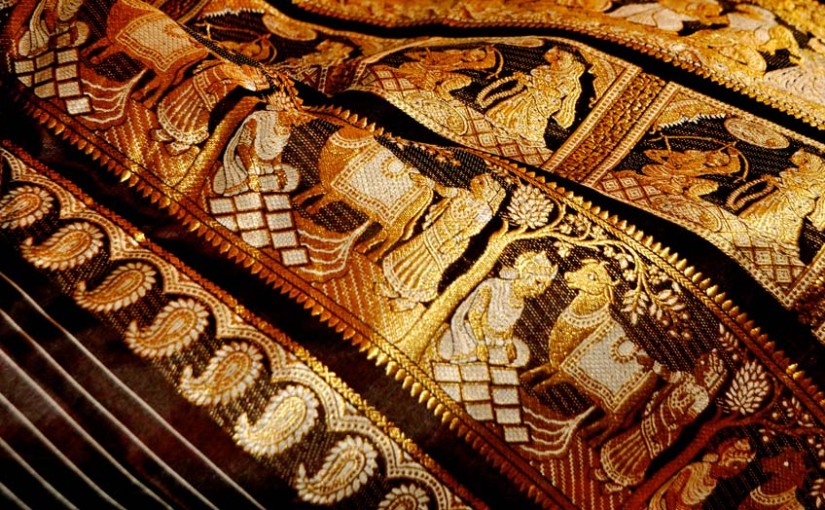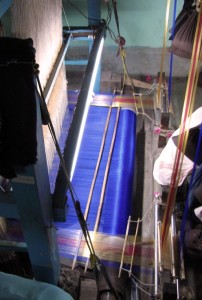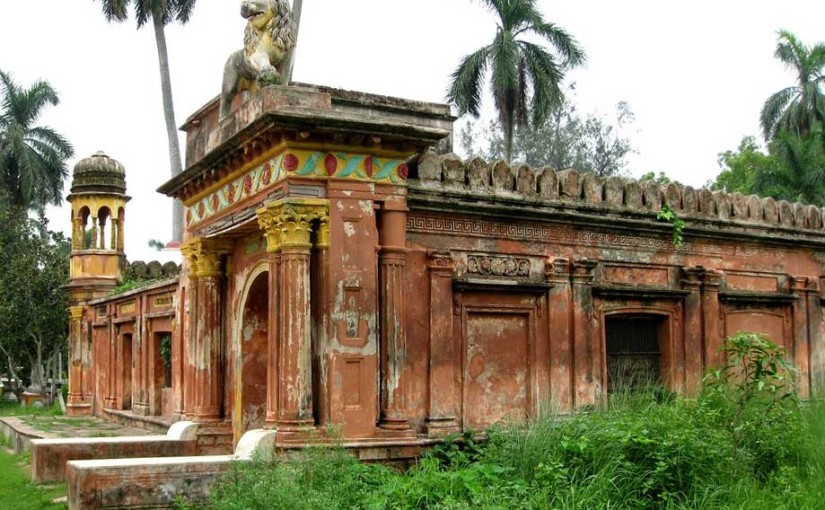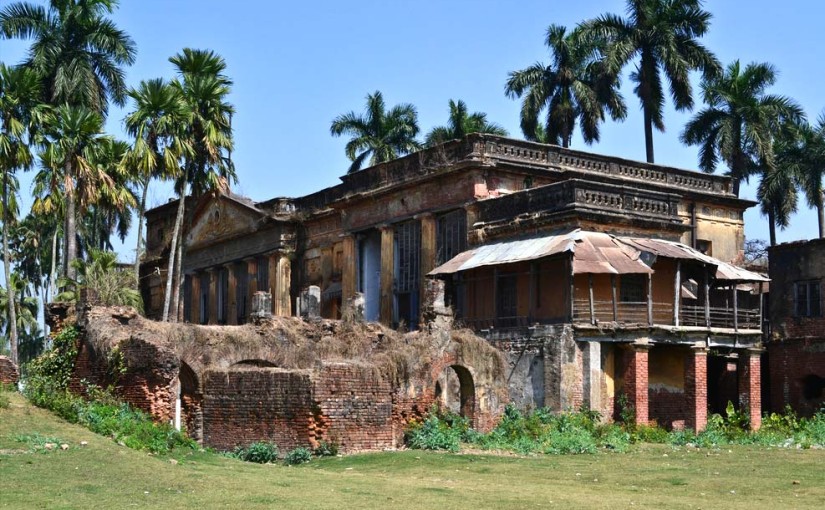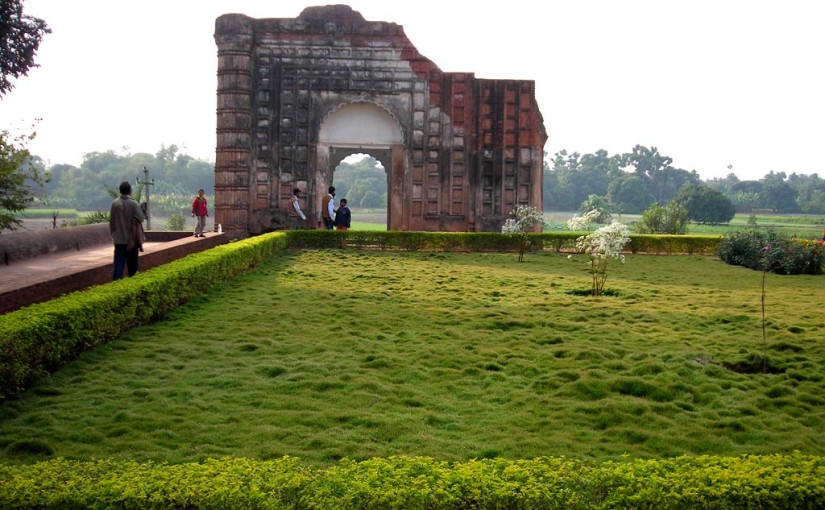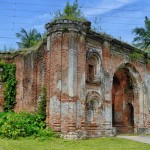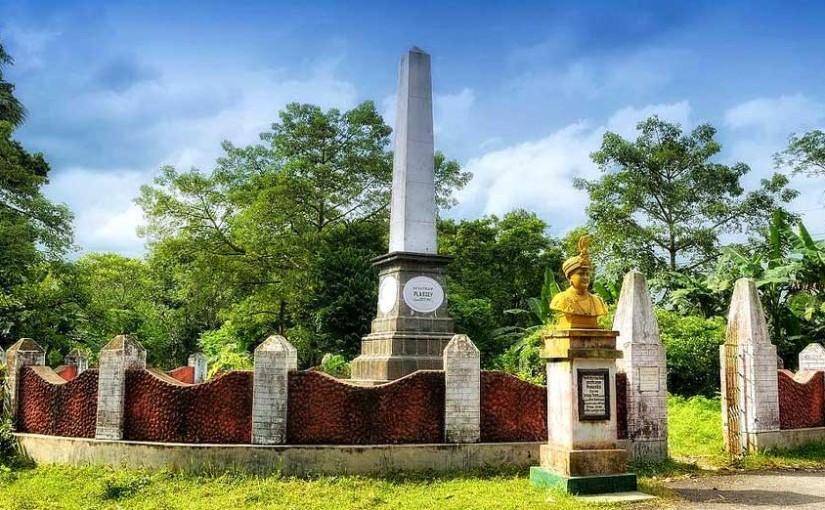The Chalk Masjid or Chowk Mosque in Murshidabad is quite a popular tourist attraction located in the south eastern side of Hazarduari Palace. It was constructed by Munny Begum, consort of Mirjafar in 1760. The Chalk Masjid stands tall on the site of Chahel Setun built during the period of Murshid Quli Khan. The exterior and the interior of the masjid is adorned with beautiful and prolific cartouche, vegetal motifs and arch shaped recess with stucco. The mosque has a grand appearance due to the 5 domes in the center with 2 ‘chau-chala-end-vaults’. It is called the ‘Chowk’ because it is an intersection of 5 roads serving as the biggest market area of the city. Pious Muslims gather inside the mosque to observe Id-ul Zoha, Id-ul Fitr, and Ramzan.
Category: West Bengal
Ghari Minar – Hazarduari, Murshidabad
The Ghari Minar or the Clock Tower of Murshidabad, West Bengal is located on coordinates 24°11′15″N 88°16′10″E / 24.187381°N 88.269315°E is a famous tourists spot. It is located to the south of Hazarduari Palace in the Nizamat Fort premises. It was erected in the garden area of Nizamat Fort probably for passengers traveling by boat and sailors. The Ghari Minar comprises of a heavy bell, the dial of a clock facing east towards Bhagirathi River and 4 masonry shields on 4 corners on the ground supported by 4 masonry lions. It is also known as the ‘Big Ben of Murshidabad’, the handles and figures of the clock being visible from the opposite bank. It was designed by Sagore Mistri, the same person who constructed Hazarduari Palace. He was the assistant to Colonel Duncan MacLeod.
Silk in Bankura and Murshidabad
Tussar Silk is produced from silkworms. It is also known as Tusser, Tushar and Tussah and the sarees made from this particular silk is very popular in India. Its popularity is due to the gold sheen and has shorter fibres. It is the chosen material for saris and also punjabis for Indian men. The gold sheen makes it appear rich textured and also shimmering. Bulk production is Tussar silk is done in India out of which around 40% is from West Bengal. The tussar silk sarees produced in Bankura are famous for their kantha stitch which is a particular type of stitching process done by hand instead of machines. Kantha stitched silk sarees are quite expensive and exquisite. Tussar silk sarees are available in various beautiful colors. Tussar silk is also used to make punjabis for men and salwar suits for ladies. These traditional apparels also appear beautiful made from this silk. Producing Tussar silk is considered to be a cottage industry in Bankura where a large number of handlooms are found. This is a tradition of Bankura and thus the weavers still maintain the conventional handloom process to produce the silk sarees. Tussar Silk is also known by another name which is Kosa Silk. Tussar Silk clothes are exported to Gulf countries, to the USA and also various European countries.
Some of the characteristic features of Tussar Silk are:
- Various natural shades
- Light and airy
- Provides a comfortable and cool feeling
- Rich coarse texture
- Delicate in nature
Maintaining Tussar Silk
Maintaining tussar silk clothes takes a little caring. Dry washing the clothes is the safest option so that it retains its natural texture. You can also use cold water for clothes other than sarees to wash off the dirt. But remember to wash it with gentle hands since it’s delicate. Avoid using chemical bleach and never dry in directly under the sun. Silk needs to breathe and hence you must not store in inside paper. Fold it nicely and store it. Some of the most popular colors in tussar silk are magenta, red, turquoise, gold, dark teal, ultramine, chocolate and purple.
Baluchari Sarees
The Bishnupur region in Bankura is famous for producing Baluchari sarees that are made from tussar silk with particular types distinct of patterns on them. Woven on Jacquard punch-card looms, the Baluchari sarees have pallus and borders with episodes from Mahabharata woven on them. These exclusive sarees woven by the weavers are beautiful specimens of traditional art. However, making Baluchari sarees entail a lengthy process. The silk strands are separately dyed and put in a loom after which punch cards hanging from the upper part of the loom are used to make the designs on the strands. The punch cards shave holes in them and are rectangular in shape with various designs on them. The dyed strands are made to pass through these holes and accumulate into precise forms on the loom making some of the most desirable sarees made from silk.
Image Source: Flickr
Footi Mosque, Murshidabad
Footi Mosque or masjid as it called in Urdu is an unfinished work of Nawab Sarafaraz Khan. It is located at a distance of a mile from Hazarduari Palace. Though unfinished the mosque has some unique architectural features that attract tourists to this spot. It is said that Sarafaraz Khan built this structure in one night.
Kathgola Palace, Murshidabad
The Kathgola Palace built in the garden premises of Raja Dhanpat Singh Dugar and Lakshmipath Singh Dugar is located in half a km South-East part of Mahimapur (modern Nashipur) town in Murshidabad. It is an impressive structure constituting a central drawing room, a library, billiard room, bedroom and dining room. Built during 1870s as a rest house amidst the garden it has porches on all 4 sides. The pool sides are beautiful providing natural ventilation. The fantastic view of the countryside from the second floor will mesmerize you. Also there is the Adinath Temple which is of immense importance to the Jains.
Image Source: Flickr
Nasipur Palace, Murshidabad
According to Holiday HotSpot, Nasipur Palace, old name Mahimapur Raj Bari is one of the primary attractions of Murshidabad which generally brims with visitors. Constructed in 1723-24 by Murshi Quli Khan this imposing structure has high minarets, huge domes and also a cemetery of the Nawab just below the staircase. Ramachandra Temple, one of the largest temples in Murshidabad is inside the palace compound. The Nasipur Palace is only 1.5kilometers from the Railway station on the Berhampore-Lalgola route.
Image Source: Flickr
Nimak Haram Deori, Murshidabad
Nimak Haram Deori is the main gate leading to Mir Jafar, the traitor’s palace Jafargunj. It is located at a distance of only 1 kilometer north from the magnificent Hazarduari. Visitors cannot enter into the palace as it is well guarded. This palace stands as the memorial of the darkest hour in the history of Bengal as Nawab Siraj-ud-Daulah was killed here in an act of the betrayal. This assassination was decisive in the colonization of Bengal and India.
Photo Courtesy: Tarun Pradhan, Flickr/Rajib Kumar Bhattacharya
War Memorial at the Battle of Plassey Ground, Murshidabad
The battle ground of Plassey lying on the banks of the Bhagirathi River holds lot of historical significance. The British East India Company defeated the last independent Nawab of Bengal Siraj-ud-Daulah in the Battle of Plassey on 23 June 1757 which decided the fate of Calcutta and India. The British built the war memorial in the same year and the statue of The Nawab was erected by West Bengal government in the recent times. Mir Jafar, the commander-in-chief of the Nawab’s army betrayed him by accepting bribe from Lord Clive sealing the fate of slavery for Indians for the next 200 years.
Image Source: Flickr
Mosque at Khoshbag Cemetary, Murshidabad
This mosque is located inside the premises of Khoshbag which is the final resting place of the Nawabs belonging to the Afshar dynasty ruling Bengal. It has the tombs of Nawab Siraj-ud-Daulah, his wife, grandfather and grandfather’s mother. Located on the west bank of Bhagirathi River, this is a famous toursist spot.
Cemetery of Siraj-Ud-Daula (Khoshbag ), Murshidabad
The cemetery of Siraj-ud-Daulah or Khoshbag as it is popularly known as is located at the Bhagirathi River bank in the west. The tomb is also shared by his wife, Lutf-un-nisa and his grandfather, Alivardi Khan. Basically Khoshbag is home to the tombs of Nawabs from the Afshar dynasty. Khoshbag covers an area of 7.65 acres of land. This is a prime holiday hotspot and thus secures a permanent place in other listings on the most notable tourist attractions in Murshidabad.
